The Owl Cluster is a bright open star cluster located approximately 7,922 light-years away in the northern constellation Cassiopeia. With an apparent magnitude of 6.4, the cluster can be observed in binoculars and small telescopes. It has the designation NGC 457 in the New General Catalogue and is listed as Caldwell 13 in Sir Patrick Moore’s Caldwell catalogue.
The Owl Cluster is one of the finest telescope targets in the northern sky. It is easy to find because it appears in the region of Cassiopeia’s W, a bright asterism that makes Cassiopeia easily recognizable. NGC 457 is also popularly known as the E. T. Cluster, Dragonfly Cluster, Kachina Doll Cluster, and Phi Cassiopeiae Cluster.
The brightest members of the Owl Cluster are blue O- and B-type stars that shine at 9th magnitude. These are hot, massive, luminous stars that burn through their supply of fuel quickly and evolve into giants or supergiants within only a few million years. They have very short lives due to their high mass. The most massive of these stars will end their lives as supernovae, while others will cast away their outer layers to form planetary nebulae and slowly fade away as dim white dwarfs.
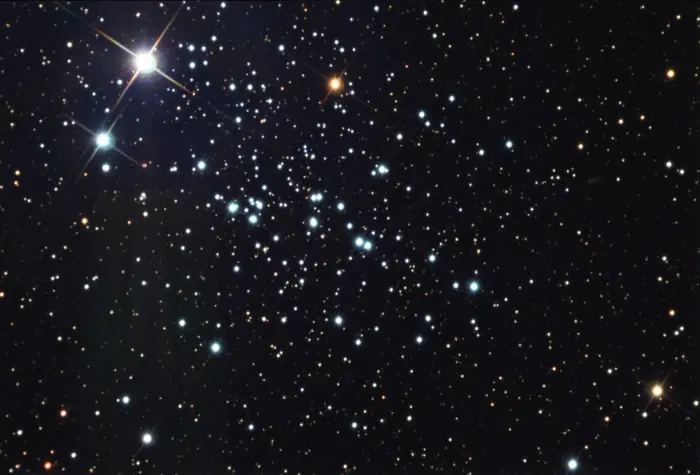
NGC 457 is an open cluster located in the constellation Cassieopeia. It is easily found in small telescopes, and a favorite for amateur astronomers who can imagine the nicknames of Owl Cluster and ET. The two bright stars in the upper left make up the eyes of ET.This image was taken as part of Advanced Observing Program (AOP) program at Kitt Peak Visitor Center during 2014. Image credit: KPNO/NOIRLab/NSF/AURA/Ken and Emilie Siarkiewicz/Adam Block (CC BY 4.0)
NGC 457 gets its most common nicknames – the Owl Cluster and the E.T. Cluster – because of two bright stars that appear in the same field, Phi Cassiopeiae and HD 7902. The two stars look like a pair of eyes, while the fainter stars form an outline of an owl or the popular character from Steven Spielberg’s 1982 film. The arms (or outstretched wings) and legs are formed by strings of cluster members and foreground stars.
NGC 457 was named the Owl Cluster by American writer David J. Eicher in the October 1980 issue of Astronomy magazine. Amateur astronomers have also called NGC 457 the Stick Man Cluster and the No. 5 Cluster (after the robot in the 1986 film Short Circuit).
The cluster has an estimated age of 21 million years.
There are about 150 stars of magnitudes 9-13 in the same rich field as the cluster. About 60 of them have been confirmed as true members. These stars formed in the same molecular cloud at about the same time and share a common proper motion through space. They are loosely bound by mutual gravity and will eventually disperse. Several faint galaxies appear in the background of the cluster, the brightest of which are 17th magnitude.
The Owl Cluster has been given the Trumpler class I 3r, indicating that it is a rich open cluster with more than 100 members, that it is concentrated towards the center and detached from the surrounding star field, and that individual stars in the cluster have a large range of brightness.
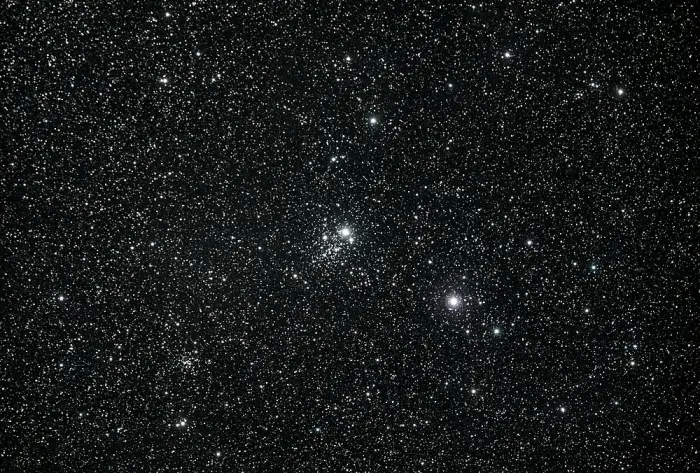
Owl Cluster (NGC 457), image: Stephen Rahn (CC0 1.0)
NGC 457 has a similar stellar population to the Double Cluster (h & χ Persei, NGC 869 and NGC 884) in the constellation Perseus. Like NGC 457, the Double Cluster is relatively young, with an estimated age of only 14 million years. In comparison, the brighter Pleiades cluster in Taurus has an age between 75 and 150 million years.
Even though Phi Cassiopeiae and HD 7902 appear in the same line of sight as NGC 457, their membership in the cluster is uncertain.
Phi Cassiopeiae appears as a single star with an apparent magnitude of 4.95 to the unaided eye, but it is in fact a multiple star system. The brightest components in the system are a yellow F-type supergiant with 6.3 times the Sun’s mass and a fainter blue B-type supergiant with a mass of 21 solar masses.
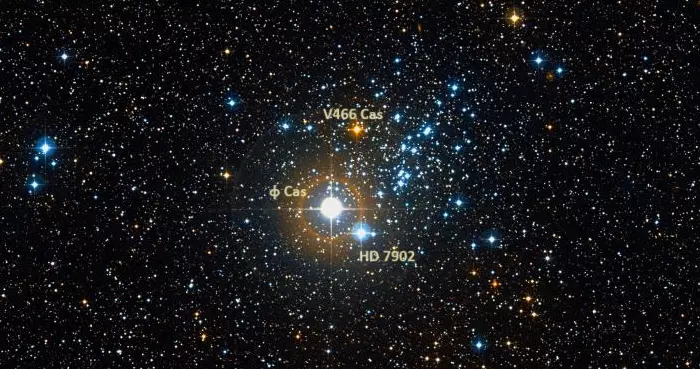
Phi Cassiopeiae, HD 7902 and V466 Cassiopeiae, image: Wikisky
Both stars have a similar motion through space as members of the Owl Cluster, but their brightness and evolutionary status make their membership unlikely. If the yellow supergiant is indeed a member, it would be one of the most intrinsically luminous stars known. It is believed to lie at a distance of 15,000 light-years, too far in the background to be a member. The star has a luminosity of 170,000 Suns and is visible to the unaided eye in good conditions, even at this distance.
The blue supergiant lies 8,900 light-years away and has a 70% likelihood of being a member. It is a suspected spectroscopic binary star.
HD 7902, the other “eye,” is also a B-type supergiant. It has the stellar classification B5Ia. The next brightest star in the cluster is V466 Cassiopeiae (HD 236697), a variable red supergiant of spectral type M0.5Ib.
Facts
NGC 457 was discovered by the German-born English astronomer William Herschel on August 18, 1780. Herschel observed the cluster with a 6.2-inch reflecting telescope and catalogued it as VII 42.
The Owl Cluster is the brightest open cluster in the constellation Cassiopeia. Cassiopeia hosts many bright and large open star clusters that can be easily observed in binoculars and small telescopes. The more famous Messier clusters M52 and M103 are both fainter than NGC 457, with apparent magnitudes of 7.3 and 7.4. Messier 52 has a similar apparent diameter to NGC 457 and Messier 103 is considerably smaller (6’).
NGC 129 between Caph and Navi (Gamma Cassiopeiae) is larger (21’) and shines at magnitude 6.5, similar to the E. T. Cluster. NGC 654 between Ruchbah and Segin also has apparent magnitude of 6.5 but is much smaller (5’). The nearby open cluster NGC 663 (Caldwell 10) is slightly larger (16’), but fainter at magnitude 7.1. The White Rose Cluster (NGC 7789, Caroline’s Rose) near Caph also has an apparent diameter of 16’ and shines at magnitude 6.7.
Location
The Owl Cluster is an excellent target for beginners. It is very easy to find because it appears next to Cassiopeia’s W, one of the most recognizable asterisms in the northern night sky. The cluster lies only two degrees south-southeast of Ruchbah (Delta Cassiopeiae), the bottom left star of the W, just left of the imaginary line extended from Segin (Epsilon Cassiopeiae) through Ruchbah.
The cluster can be seen in binoculars, which will reveal a fuzzy ball of light. At magnitude 6.4 it is on the border of unaided-eye visibility and may be spotted in ideal observing conditions. A 3-inch refractor telescope will reveal a group of about two dozen bright members. An 8-inch reflector will resolve up to a hundred stars.
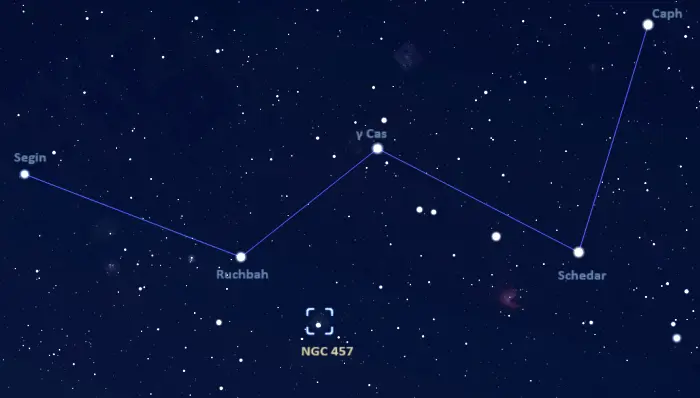
The location of the Owl Cluster (NGC 457), image: Stellarium
Several other bright clusters appear in the same region, near Ruchbah. They include Messier 103, NGC 663, and NGC 654. The planetary nebula Sh2-188, popularly known as the Shrimp Nebula or the Dolphin Nebula, appears near NGC 457 in the sky.
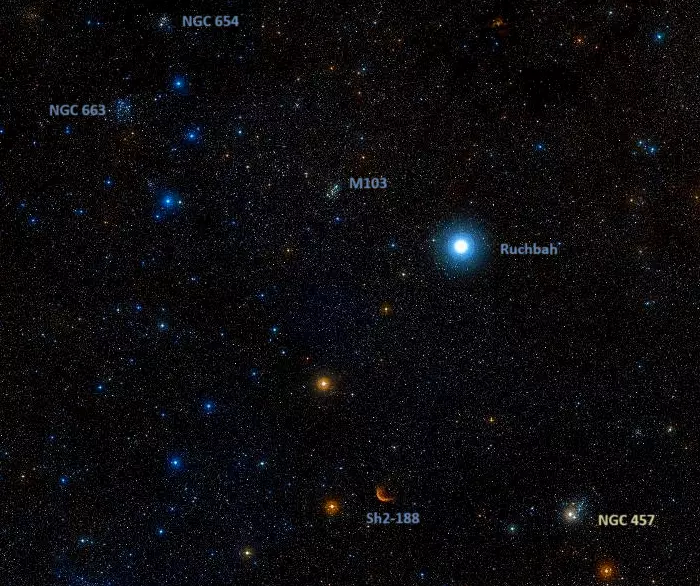
The Owl Cluster, Messier 103, NGC 663 and NGC 654, image: Wikisky
The Owl Cluster lies in the northern sky and is best observed from the northern hemisphere. The constellation Cassiopeia is visible throughout the year for northern observers. The best time of the year to observe the stars and deep sky objects in the constellation is during the months of October and November, when Cassiopeia’s familiar W asterism is prominent above the horizon in the evening.
At declination 58° 17’, the celestial E.T. never rises for observers south of the latitude 31° S. It only appears low above the northern horizon from the southern equatorial locations. From locations north of the latitude 31° N, the cluster is circumpolar, i.e. visible throughout the year.
Owl Cluster – NGC 457
| Constellation | Cassiopeia |
| Right ascension | 01h 19m 32.9s |
| Declination | +58° 16′ 41″ |
| Apparent magnitude | 6.4 |
| Apparent size | 15.0′ |
| Distance | 7,922 light-years (2,429 parsecs) |
| Age | 21 million years |
| Names and designations | NGC 457, Owl Cluster, ET Cluster, Phi Cassiopeiae Cluster, Dragonfly Cluster, Kachina Doll Cluster, Caldwell 13, Melotte 7 (Mel 7), Collinder 12 (Cr 12), Lund 43, GC 256, OCL 321, H VII-42, h 97, OCISM 73, MWSC 0114, Theia 772 |